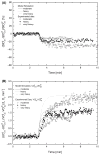Relating pulmonary oxygen uptake to muscle oxygen consumption at exercise onset: in vivo and in silico studies
- PMID: 16636861
- PMCID: PMC4124916
- DOI: 10.1007/s00421-006-0176-y
Relating pulmonary oxygen uptake to muscle oxygen consumption at exercise onset: in vivo and in silico studies
Abstract
Assessment of the rate of muscle oxygen consumption, UO(2m), in vivo during exercise involving a large muscle mass is critical for investigating mechanisms regulating energy metabolism at exercise onset. While UO(2m) is technically difficult to obtain under these circumstances, pulmonary oxygen uptake, VO(2p), can be readily measured and used as a proxy to UO(2m). However, the quantitative relationship between VO(2p) and UO(2m) during the nonsteady phase of exercise in humans, needs to be established. A computational model of oxygen transport and utilization--based on dynamic mass balances in blood and tissue cells--was applied to quantify the dynamic relationship between model-simulated UO(2m) and measured VO(2p) during moderate (M), heavy (H), and very heavy (V) intensity exercise. In seven human subjects, VO(2p) and muscle oxygen saturation, StO(2m), were measured with indirect calorimetry and near infrared spectroscopy (NIRS), respectively. The dynamic responses of VO(2p) and StO(2m) at each intensity were in agreement with previously published data. The response time of muscle oxygen consumption, tauUO(2m) estimated by direct comparison between model results and measurements of StO(2m) was significantly faster (P < 0.001) than that of pulmonary oxygen uptake, tauVO(2p) (M: 13 +/- 4 vs. 65 +/- 7 s; H: 13 +/- 4 vs. 100 +/- 24 s; V: 15 +/- 5 vs. 82 +/- 31 s). Thus, by taking into account the dynamics of oxygen stores in blood and tissue and determining muscle oxygen consumption from muscle oxygenation measurements, this study demonstrates a significant temporal dissociation between UO(2m) and VO(2p) at exercise onset.
Figures





References
-
- Auchincloss JH, Jr, Gilbert R, Baule GH. Effect of ventilation on oxygen transfer during early exercise. J Appl Physiol. 1966;21:810–818. - PubMed
-
- Audi SH, Linehan JH, Krenz GS, Dawson CA. Accounting for the heterogeneity of capillary transit times in modeling multiple indicator dilution data. Ann Biomed Eng. 1998;26:914–930. - PubMed
-
- Barstow TJ, Lamarra N, Whipp BJ. Modulation of muscle and pulmonary O2 uptakes by circulatory dynamics during exercise. J Appl Physiol. 1990;68:979–989. - PubMed
-
- Beard DA. Computational framework for generating transport models from databases of microvascular anatomy. Ann Biomed Eng. 2001;29:837–843. - PubMed
Publication types
MeSH terms
Substances
Grants and funding
LinkOut - more resources
Full Text Sources
Medical

